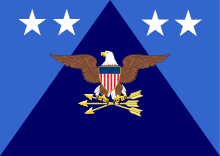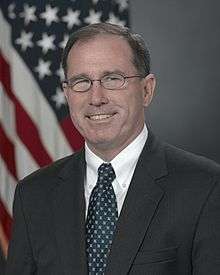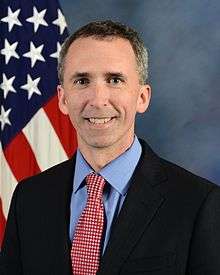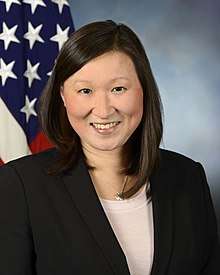Under Secretary of Defense for Intelligence
| United States Under Secretary of Defense for Intelligence | |
|---|---|
 | |
| Formation | March 11, 2003 |
| First holder | Stephen Cambone |
| Website | |
The Under Secretary for Intelligence or USD(I) is a high-ranking civilian position in the Office of the Secretary of Defense (OSD) within the U.S. Department of Defense that acts as the principal civilian advisor and deputy to the Secretary and Deputy Secretary of Defense on matters relating to military intelligence.
The Under Secretary is appointed from civilian life by the President and confirmed by the Senate to serve at the pleasure of the President.[1] On July 17, 2017, President Donald J. Trump announced his intention to nominate retired Vice Admiral Joseph D. Kernan, a former Navy SEAL, as Under Secretary of Defense for Intelligence [2].
Overview
The Office of the Under Secretary of Defense for Intelligence (OUSD(I)) is principal staff element of the Department of Defense regarding intelligence, counterintelligence, security, sensitive activities, and other intelligence-related matters. As the Secretary of Defense's representative, the USD(I) exercises oversight over, among others, the Defense Intelligence Agency (DIA), the National Geospatial-Intelligence Agency (NGA), the National Reconnaissance Office (NRO) and the National Security Agency (NSA). In addition, the Under Secretary is also dual-hatted, serving as the Director of Defense Intelligence under the Office of the Director of National Intelligence.[3]
With the rank of Under Secretary, the USD(I) is a Level III position within the Executive Schedule. Since January 2010, the annual rate of pay for Level III is $165,300.
History
The position of Under Secretary of Defense for Intelligence was created by the National Defense Authorization Act for Fiscal Year 2003 in the aftermath of the September 11 terror attacks to better coordinate Department-wide intelligence activities. It became second in the line of succession for the Secretary of Defense, after the Deputy Secretary of Defense, after an executive order was made by President George W. Bush on December 22, 2005. When it was created, the legislation described it as taking precedence in the Department behind the Under Secretary for Personnel and Readiness.[1][4]
On November 23, 2005, a Department of Defense Directive was made by Secretary Rumsfeld that stated that the Under Secretary shall serve as the Secretary's primary representative to the Office of the Director of National Intelligence. It also stated the Under Secretary shall provide policy and oversight on the training and career development of personnel in Department of Defense's counterterrorism, intelligence, and security components. The Under Secretary has the duty of finding candidates to be nominated to serve as Directors of the Defense Intelligence Agency, the National Geospatial-Intelligence Agency, the National Reconnaissance Office, and the National Security Agency, and overseeing their performance.
The USD(I) became a dual-hatted position as Director of Defense Intelligence, acting as the primary military intelligence advisor to the DNI. This additional position follows a May 2007 memorandum of agreement between Secretary of Defense Robert Gates and Director of National Intelligence John Michael McConnell to create the position.[3]
Reporting Officials
Officials reporting to the USD(I) include:
- Deputy Under Secretary of Defense for Joint and Coalition Warfighter Support
- Deputy Under Secretary of Defense for Technical Collection and Analysis
- Deputy Under Secretary of Defense for Portfolio, Programs and Resources
- Deputy Under Secretary of Defense for HUMINT, Counterintelligence and Security
- Director, Defense Security Service
- Director, Defense Intelligence Agency
- Director, National Geospatial-Intelligence Agency
- Director, National Security Agency/Central Security Service
- Director, National Reconnaissance Office
Office of the Under Secretary
The Under Secretary leads the Office of the Under Secretary of Defense for Intelligence (OUSD-I). A unit of the Office of the Secretary of Defense, OUSD-I exercises planning, policy, and strategic oversight over all Department of Defense intelligence, counterintelligence, and security matters. OUSD-I serves as the primary representative of the Defense Department to the Director of National Intelligence and other members of the United States Intelligence Community.
The work of OUSD-I is conducted through its several staff directorates, including:
- Under the direction of the Deputy Under Secretary for Joint Coalition Warfighter Support
- Information Operations (IO) and Strategic Studies Directorate – Advisor for DoD Cyber, IO integration and IO-enabling strategic activities
- Warfighter Requirements and Evaluation Directorate – Provides guidance and oversight to sustain the Intelligence Planning process to synchronize and integrate national and Defense Intelligence Enterprise efforts in support of selected combatant command top priority contingency and campaign plans
- Policy, Strategy, and Doctrine Directorate – Provides oversight, development, and management of Defense Intelligence, Counterintelligence, security and intelligence-related policy, strategy, and doctrine, and establishes priorities to ensure conformance with Secretary of Defense and Director of National Intelligence guidance
- Information Sharing and Partner Engagement Directorate – Coordinates all intelligence information sharing and related Warfighter intelligence support issues for the Under Secretary
- Intelligence, Surveillance and Reconnaissance (ISR) Directorate – Responsible for operationalizing approved ISR initiatives. Provides ISR capability with supporting infrastructure for collection, communications and processing, exploitation and dissemination in support of commands engaged in combat operations
- Under the direction of the Deputy Under Secretary of Defense for Technical Collection and Analysis
- Analytic Concepts and Strategies Directorate – Stimulates, develops and implements advanced concepts, responsive strategies, and cutting-edge analytic tradecraft methodologies, techniques and procedures that focus on improving the full spectrum of analysis and maximizing the integration and collaboration between technical analysis and all-source analysis
- Collection Concepts and Strategies Directorate – Stimulates, develops and implements advanced concepts, responsive strategies, and cutting-edge integration methodologies, techniques and procedures
- Special Capabilities Directorate – Develops, oversees, and manages special activities addressing critical intelligence needs, operational shortfalls, and interagency requirements
- Under the direction of the Deputy Under Secretary of Defense for Portfolio, Programs and Resources
- Battlespace Awareness (BA) Portfolio Directorate – Serves as the principal staff advisor and functional manager for the Department’s BA Portfolio
- Intelligence, Surveillance and Reconnaissance Programs Directorate – Provides functional oversight for DoD ISR programs, to include processing, exploitation, and dedicated communications networks
- Military Intelligence Program Resources Directorate – Develops investment strategies addressing Warfighter near-term and long-term ISR and other intelligence-related needs
- Under the direction of the Deputy Under Secretary of Defense for HUMINT, Counterintelligence and Security
- Counterintelligence Directorate – Staff advisor for Department Counterintelligence and Credibility Assessment matters
- HUMINT Directorate – Staff advisor for Department HUMINT, overseeing the full spectrum of Department HUMINT plans, programs, and operations, to include Identity Intelligence biometrics
- Security Directorate – Staff advisor for Department security policy, planning, and oversight, and Executive Agent for the National Industrial Security Program
- Sensitive Activities Directorate – Staff office concerning Department Sensitive Activities, National programs, Defense Sensitive Support and sensitive Special Operations
- Direct Report Offices – Central administrative activity of the OUSD-I for legislative affairs, human capital, management, and policy oversight
Budget
Budget Totals
The annual budget for the USD(I) is contained in the Office of the Secretary of Defense's (OSD) budget, under the Defense-Wide Operation and Maintenance (O&M) account.
| Line Item | FY10 Actual | FY11 Estimate | FY12 Request |
|---|---|---|---|
| Core OSD Operating Program[6] | |||
| Civilian Pay and Benefits, USD (I) | 32,516 | 38,406 | 32,891 |
| Program Structure[7] | |||
| Intelligence Mission | 55,461 | 85,796 | 74,315 |
| International Intelligence Technology | 11,519 | 80,643 | 80,548 |
| Defense Civilian Intelligence Personnel System | 4,198 | 2,392 | 2,047 |
| Joint Military Deception Initiative | 2,840 | 3,064 | 4,458 |
| Travel | 1,458 | 1,750 | 1,571 |
| Overseas Contingency Operations[8] | |||
| OCO OUSD (Intel) | 57,849 | 0 | 0 |
| Totals | |||
| Total Budget | 165,841 | 212,051 | 194,416 |
Budget Features
- Intelligence Mission – Provides funding for the four Deputy Under Secretaries of OUSD(I) as well as four direct reporting agencies:
- DUSD Joint and Coalition Warfighter Support (J&CWS) – Ensures that intelligence support across the Department meets critical and timely Warfighter needs and requirements through policy development, planning, and operational oversight
- DUSD Technical Collection and Analysis (TC&A) – Provides direction and oversight of all DoD intelligence analytical and technical collection functions
- DUSD Portfolio, Programs and Resources (PP&R) – Develops Defense Department investment strategy for Intelligence, Surveillance, and Reconnaissance (ISR) and Environmental system capabilities
- DUSD HUMINT, Counterintelligence and Security (HCI&S) – Responsible for developing policy and exercise planning, and strategic oversight for the Department of Defense in the areas of HUMINT, Counterintelligence (CI), security and sensitive activities
- International Intelligence Technology – Develops, coordinates, oversees, and manages OUSD(I)’s technology and architectural analysis and support to allied and coalition intelligence sharing and exchange requirements. Conducts research, analysis, and coordination to advance and integrate DoD, NATO, and coalition intelligence sharing, exploitation, and dissemination
- Defense Civilian Intelligence Personnel System (DCIPS) – DCIPS implementation enables Defense Department intelligence agencies to more effectively establish positions and appoint, pay, develop, retain, and motivate a world-class workforce committed to providing effective intelligence support to the Warfighter and the national policy maker
- Joint Military Deception Initiative – Funds an initiative to revitalize Defense Department military deception planning and execution capability in the Unified Combatant Commands
- Travel – Funds employee travel in support of OUSD(I) mission
Office holders
| Portrait | Name | Tenure | SecDef(s) served under | President(s) served under |
|---|---|---|---|---|
 | Stephen Cambone | March 11, 2003 – December 31, 2006 | Donald Rumsfeld Robert Gates | George W. Bush |
 | James R. Clapper | April 15, 2007 – August 9, 2010 | Robert Gates | George W. Bush Barack Obama |
 | Michael G. Vickers | March 16, 2011 – April 30, 2015[10] | Robert Gates Leon Panetta Chuck Hagel | Barack Obama |
 |
Marcel Lettre | May 1, 2015 – December 16, 2015 | Ashton Carter | |
| December 16, 2015 – January 20, 2017 | ||||
 | Kari Bingen | May 25, 2017 – present | James Mattis | Donald Trump |
References
- 1 2 "getdoc.cgi" (PDF). Retrieved September 22, 2007.
- ↑ https://www.whitehouse.gov/the-press-office/2017/07/17/president-donald-j-trump-announces-intent-nominate-personnel-key
- 1 2 "Under Secretary of Defense for Intelligence to be Dual-hatted as Director of Defense Intelligence," DNI News Release, May 24, 2007
- ↑ "Executive Order: Providing An Order of Succession Within the Department of Defense". Office of the Press Secretary. Retrieved December 22, 2005.
- ↑ "Fiscal Year (FY) 2012 Budget Estimates, Office of the Secretary of Defense (OSD)" (PDF). Under Secretary of Defense (Comptroller), OSD. 2011. Retrieved 2011-08-29.
- ↑ Fiscal Year (FY) 2012 Budget Estimates, Office of the Secretary of Defense (OSD), p.664
- ↑ Fiscal Year (FY) 2012 Budget Estimates, Office of the Secretary of Defense (OSD), p.697-707
- ↑ Fiscal Year (FY) 2012 Budget Estimates, Office of the Secretary of Defense (OSD), p.714
- ↑ "Department of Defense Key Officials" (PDF). Historical Office, OSD. 2004. Retrieved 2011-02-01.
- ↑ "Vickers Stepping Down as Undersecretary for Intelligence". U.S. DEPARTMENT OF DEFENSE.


